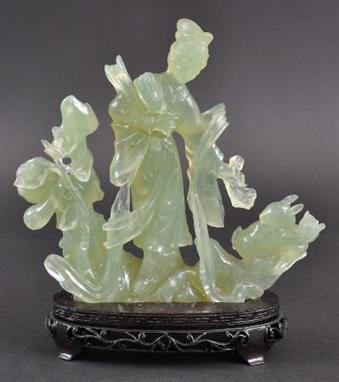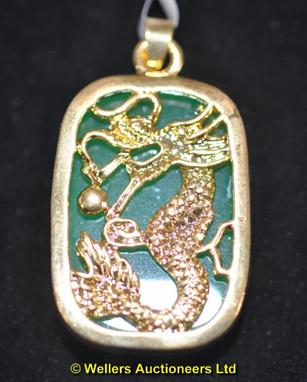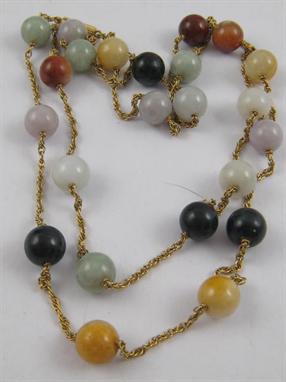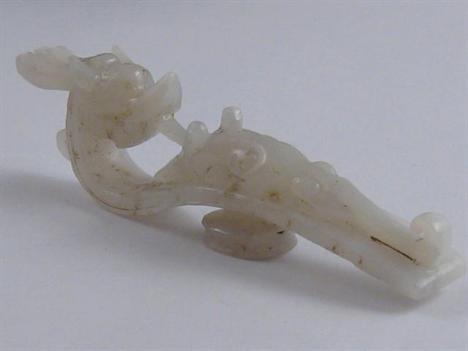We found 64936 price guide item(s) matching your search
Receive email alerts when new lots matching "A Jade" come up for sale.
Receive email alerts when new lots matching "A Jade" come up for sale.
There are 64936 lots that match your search criteria. Subscribe now to get instant access to the full price guide service.
Click here to subscribe- List
- Grid
-
64936 item(s)/page
A Chinese jade carving of a tiger, each side carved in shallow relief with stylized stripes, and crouched ready to pounce, the celadon coloured stone flecked with brown markings and striations, probably Ming dynasty, 20cm. Paper label for John Sparks Ltd., 128 Mount Street. Provenance: Sackville, 5th Earl of Yarborough.
A Chinese mottled jade blade or ge, with a meridian ridge running along the length of the blade, well worked on either side and with one drilled fastening hole, the greyish stone mottled with brown inclusions, Shang dynasty c.1600 - 1100BC, 25.5cm. Provenance: Sackville, 5th Earl of Yarborough. Jade blades of this type were ceremonial reproductions of bronze ge blades, used as infantry weapons in the Shang and Western Zhou dynasties.
A Moghul jade-handled dagger, the handle issuing seed pods and carved in shallow relief with stylized flowers and foliage, the blade with gilt tracery, the scabbard with gilt metal mounts, 18th/19th century, 40cm overall. (2) Provenance: Sackville, 5th Earl of Yarborough. Cf. Exquisite Beauty - Islamic Jades, National Palace Museum, no.146, p121, for a related example.
A Moghul jade rectangular box, with a sliding cover, carved in shallow relief with stylized scrolling flowers and foliage, supported on four shaped feet, the pale celadon stone with grey mottling and striations, 18th/19th century, minor damages, 11.6cm. (2) Provenance: Sackville, 5th Earl of Yarborough, purchased from John Sparks Ltd., for 24 guineas, and recorded in the Sparks archive.
A good Chinese pale celadon jade mallow dish, with six compartments divided by S-scrolls, unmarked, 18th/early 19th century, 12.5cm. Provenance: Sackville, 5th Earl of Yarborough, purchased from John Sparks Ltd., for 25 guineas, and recorded in the Sparks archive. Cf. R. Keverne, Fine and Rare Chinese Works of Art and Ceramics, Summer Exhibition, 16 June 2006, no.100, p.103 for another example in jade.
A Moghul pale celadon jade dagger hilt, carved in shallow relief with stylized leaves and terminating in scrolls, 18th/19th century, 13.5cm. Cf. Exquisite Beauty, Islamic Jades, National Palace Museum, no.139, p.117 for a related example. Chinese Porcelain from the collection of Professor D R Laurence md
A fine Chinese cloisonne ink-stick stand, the rectangular top decorated with the Eight Horses of Mu Wang, raised as a gilt edged panel on a base with scroll ends decorated with stylized lotus, on a turquoise ground, the borders Royal blue with a gilt scroll, unmarked, Qianlong 1736-95, 10.3cm. Together with a related wooden box cover inscribed bao mo tai (precious ink stand). (2) Provenance: by repute Mr Hetherington, a member of the British diplomatic staff at the Japanese embassy in the 1890s. Cf. China, The Three Emperors 1662-1795, p.227 for a yellow jade example from the Palace Museum, Beijing.
A Chinese pale celadon jade cup, formed as a prunus blossom and surrounded by openwork stems and leaves with four further flower heads, Ming dynasty, c.16th century, inventory no.30121, 12.5cm. Provenance: an important European private collection formed in the 19th century by a Russian nobleman and diplomat. Cf. The Complete Collection of Treasures of the Palace Museum, Jadeware II, no.198 for a similar Ming example and another, J Rawson, Chinese Jade from the Neolithic to the Qing, p.389, fig.7.
A small Chinese pale celadon jade oval cup, the border carved with a key fret band and one end with a chilong dragon clasping the rim and forming a handle, 18th/19th century, 8.5cm. Provenance: an important European private collection formed in the 19th century by a Russian nobleman and diplomat.
A Chinese jade vase-shaped plaque, from a wall panel with scrolling handles, a shallow bowl with a silver coloured metal rim and another incised with fruiting peach branches, 18th/19th century, some damages, 13.5cm. (3) Provenance: an important European private collection formed in the 19th century by a Russian nobleman and diplomat.
A Chinese jade cup, the grey green stone carved as a melon with an elaborate openwork handle of tendrils, leaves, scrolls and flower heads, the base as a cinquefoil leaf, 18th century, a 2cm rim chip, 11.4cm. Provenance: an important European private collection formed in the 19th century by a Russian nobleman and diplomat.
A Chinese celadon jade vase, finely carved with a scaly sinuous dragon climbing up one side and with two smaller chilong dragons to the reverse, amidst cloud scrolls in shallow relief, the rim and foot with key fret bands, Qianlong 1736-95, together with a reticulated wood stand, 18cm. (2) Provenance: an important European private collection formed in the 19th century by a Russian nobleman and diplomat.
A Chinese jade ewer, each side carved in shallow relief with a phoenix, their heads standing proud at the border, the handle formed as a mythical beast and raised on a slightly flared foot, Ming dynasty, inventory no.30118, 9.1cm. Provenance: an important European private collection formed in the 19th century by a Russian nobleman and diplomat.
A large Chinese archaistic spinach-green jade bowl, the domed cover applied with a pale celadon jade reticulated finial, carved as a scaly dragon amidst cloud scrolls, the bowl with side handles carved as the winged and horned heads of mythical creatures, the body and cover with stylized taotie masks on a key fret ground, the finial Ming dynasty, the bowl and cover 18th/19th century, inventory no.30107, 21.5cm wide. (2) Provenance: an important European private collection formed in the 19th century by a Russian nobleman and diplomat.
A Chinese pale celadon jade belt plaque, reticulated and finely carved with a writhing scaly dragon amidst ruyi fungus, Ming dynasty 15th/16th century, 9.5cm. Cf. Littleton and Hennessy, The Imperial Studio, November 2009, no.18, For a similar plaque inset in a Zitan stand and also Rawson, Chinese Jade from the Neolithic to the Qing, p327 fig.8 for another example.
-
64936 item(s)/page

























































